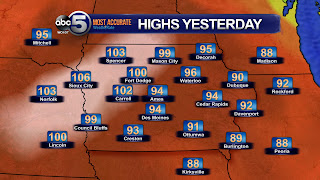 |
| The face of a severe super-cell storm. This storm later ended Iowa's historic tornado-free streak with tornadoes near Adel, Dallas Center and Huxley. 5-19-2013 |
 |
| Wind damage near Dallas Center 5-19-2013. |
There's a new storm on the horizon, and it's a siege against conservation and human health. I'm talking nitrates and water pollution. From our own reporters at ABC5 to bloggers reporting to Field and stream and even the Des Moines Register, the problem is coming up to the surface like that floating fish in Big Creek. "Nitrates are at levels we've not seen ever before and we're seeing it right now." Bill Stowe. The nitrate removal system that scrubs the river water clean of pollutants costs $7,000 each day, a tremendous cost to the rate payers and residents of Des Moines that are being slowly polluted. This is a terrible problem, one that has a solution... a solution that has been ignored by the would-be stewards of the land. The problem is a perfect storm where conventional agriculture, high crop prices, and rainwater run-off into streams all meet. The result is higher crop yields in exchange for low water quality. The victims are you, me and the game animals we pursue. And the issue is not new in Iowa, but it is growing into a bigger problem.
So how does it happen? Conventional farming practices are being pushed to the edge of the property lines and limits of productivity. We are taking more out of the ground than we're putting back in, depleting organic matter that decays and supplies next year's crop with more food. To counteract this, farmers inject the ground with fertilizer. Until the plants can access this food, it remains in the soil and leeches into the groundwater. If unfortunate -yet typical- circumstances bring heavy spring rains in over freshly fertilized fields, runoff effectively transports those nutrients straight into the streams, rivers and yes your faucets. That's called Spring in Iowa and this happens every time the rivers rise and the water turns murky. It also feeds algo-blooms later on in the season, but that's another story.
From beaver dams to cattails and wetlands, nature naturally slows water's progress and buffers the rivers and streams. This is the land's built-in a water filtration system. Slowing water allows nutrients to settle into soil to later be used by lucky plants. But instead of slowing water's return to the lakes and eventually the sea, farmers are bulldozing those trees and "weeds" lining either side of that old fence row and the winding creek. Pressured by the economy and world demand for yield, we are now more than ever farming right up to the edge. This destroys habitat for game, it diminishes the land's ability to filter out runoff pollution and it ironically makes water erosion issues even worse.
For farmers who take this path, it is a slippery slope. In spite of expensive efforts to tile and drain the water into the streams and rivers, we are removing the waterways that protect our crops and the future yield. A tiled landscape brings high volumes of water straight to the stream, creek or river with disturbing efficiency. It gives even more power to the next heavy thunderstorm. When the weather pattern's wet, tiling keeps the tractors from getting stuck and the plants from drowning. It also raises the flooding threats as water wastes no time soaking into the ground. Farmers who choose to bulldoze that waterway and make that extra buck will see volumes more of their own property swept down stream every heavy rain. The water will rage, soil in tow, unabated by those "weeds" whose roots once stood as the last defense before the muddy flood water's devastating power. If for some ignorant reason, you don't care about the farm fields, did I mention high concentrations of nitrates can cause substantial health issues?
 |
| Source here. |
So what's the solution? Well, as much as yelling at me or calling me names may make you feel better, it wont stop the floods. And they will come. We're embarking on an extreme weather pattern for the next 10-20 years. This could spell drought right next to floods, Winter right next to Summer. And we've already set sail into this rough sea. Farmers need to consult with outdoorsmen and conservationists to come up with a solution unique to their property. Perhaps it's channeling excess runoff into a buffered pond deep enough the silt can build for years without ill effect. It could later be pumped back to the land where it once came instead of buying fertilizer. Or perhaps it's leaving that tall-grass buffer along the winding creek. You may not get more income from farming this year, but there'd be no need to tile. And hunting over that little strip of property insurance in the fall is just icing on the cake. There is a balance unique to every landscape that can protect both the land and the yields for the future. Find it- and soon. At least before the next flood dries up into another extreme drought as it may this very summer.
From one happy note to another, our biggest flooding rains of 2013 could potentially begin this Memorial day weekend. A stalled front and a sluggish storm system will all pull into the picture and park with unfortunate coincidence for Iowa. A low-level southerly will transport humidity (atmospheric energy and moisture) and a weak upper jetstream from the northwest will help organized storms dump rounds of heavy rain on the state. The stalled front will focus the potential for flash flooding this weekend right on Iowa, so be sure to take the weather radio and try not to camp right next to the river. If the pattern doesn't break next week, long term and potentially major flooding is possible heading into June.
Sorry this post may be a downer, but water pollution is preventable. Conservation is necessary because pollution kills. It harms our environment and as much as technology may make us feel outside or even above this Earth, people are a part of it. People will become sick from water contaminates. Ecosystems will die from imbalance. Let's fix it, just like you'd pick up that trash next time you're hiking for that last morel mushroom or sitting down to toss in a line by that murky stream. It used to be clearer, and it can be again. Help us fix it.

























